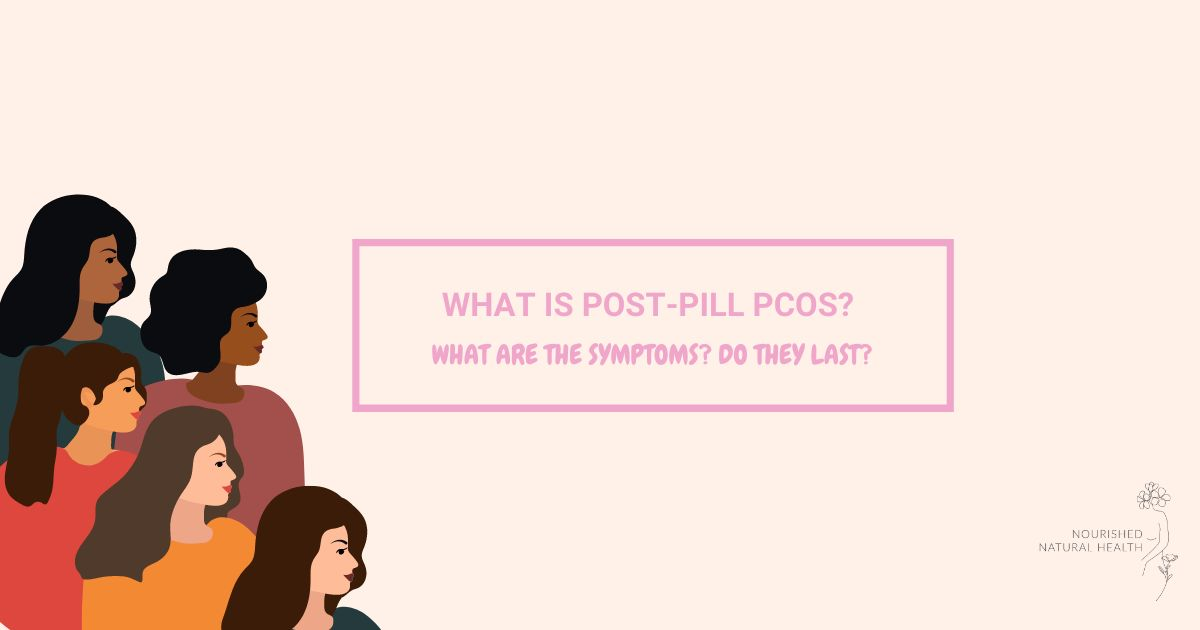Post-pill PCOS is temporary and may last for a couple of months as the body adjusts to hormone changes.
Traditional PCOS is permanent and requires careful PCOS management and supplementation.

Oftentimes, birth control pills or oral contraceptive pills are the first-line course of medical treatment offered for many types of menstrual irregularities, that too without considering the root cause of the hormonal challenge.
Although polycystic ovarian syndrome (PCOS).
Although PCOS management is not the intended purpose of birth control pills, they have been found effective to a certain degree in inducing monthly bleeds, managing premenstrual syndrome, reducing dysmenorrhea, and decreasing the risk of ovarian cancer.
Proponents of more holistic PCOS management methods argue that using birth control may address PCOS symptoms for a while, therefore “masking” unpleasant conditions like acne, hirsutism, and hair loss — only to induce post-pill PCOS once a woman decides to stop taking birth control for any reason.
Let’s take a look at the specific factors that may cause post-pill PCOS symptoms to flare up.
Birth control pills contain synthetic hormones and ingredients that may affect how the body produces hormones and processes them.
Taking birth control for a long time can affect hormonal functions, with the body getting used to consistently receiving ingredients and hormones contained in the pill.
When you stop taking contraceptives, your body has to adjust to the sudden absence of the medication, leading to a change in hormone levels within the body.
Doing so may cause a temporary hormonal imbalance while the body gets used to not taking the pill again.
Nutritional deficiencies are one of the main side effects of taking the birth control pill regularly for an extended time.
Some of the most commonly depleted nutrients are B vitamins, vitamin C, folate, vitamin E, zinc, magnesium, and selenium.
If not addressed properly, these micronutrient deficiencies can further disrupt your hormonal function and affect other areas of your well-being.
Research shows that birth control pills can cause widespread metabolic and inflammatory side effects.
However, it appears that consistent use over time does not cause these effects to accumulate and that they tend to reverse once the pill is discontinued.
Hence, metabolic changes can still be reversed using a holistic and natural PCOS management system even post-pill.
Irregular periods are a common but temporary side effect that most people may notice after stopping hormonal birth control.
The natural menstrual cycle usually takes around 3 months to get back to normal.
Another common and unfortunate symptom of post-pill PCOS is the worsening (or appearance) of hormonal acne.
When one has PCOS, acne is usually the result of an overproduction of androgens in the body, and it can be resolved by taking a proactive approach to naturally reduce androgens after quitting the pill.
Hirsutism is a condition wherein a person experiences an excess of hair growth on their body.
In women, the most common areas for unwanted hair growth are male-pattern areas of growth like the face, chest, and abdomen.
Post-pill PCOS symptoms may mimic premenstrual syndrome (PMS) symptoms and could include bloating, cramps, and mood swings.
However, post-pill symptoms tend to be more intense than PMS ones.
In some cases, women may also develop pregnancy-like symptoms like nausea and breast tenderness.
When hormonal contraceptives are removed from your body (for example, when you stop taking the pill or your implant is removed), your hormone levels will fluctuate and take time to settle down.
These hormonal fluctuations can trigger or worsen anxiety.
Unfortunately, experts currently do not recognize post-pill PCOS as an official medical condition.
As such, it is something that is typically determined by women who have taken birth control and have started experiencing PCOS symptoms.
Holistic practitioners may also aid in identifying post-pill PCOS, as can doctors who have learned to recognize post-pill PCOS symptoms.
After quitting birth control, women can experience a withdrawal from it, causing a surge of androgens that induce post-pill PCOS.
These types of birth control pills are typically referred to as those with a low androgen index and can thus disrupt your hormones and induce PCOS symptoms.
This is most common in drospirenone or cyproterone pills like Yaz, Yasmin or Diana.
Post-pill PCOS is temporary, however, and should resolve in 6 to 12 months after quitting.
A lot of people may notice symptoms of post-pill PCOS within 4 to 6 months of stopping birth control.
Period irregularity is one of the short-term symptoms that can resolve in months. Other symptoms include acne, hair loss, and fertility issues.
Additional symptoms that may need long-term support include digestive problems, weight gain, anxiety, and depression.
However, it’s worth noting that not all women quitting birth control experience post-pill PCOS. Some people won’t experience PCOS symptoms at all after stopping the pill.
Some factors that may affect how the body adapts to quitting the pill are:
There isn’t substantial research, however, other than anecdotal evidence, that backs up the theory that certain groups are more predisposed to post-pill PCOS.
These groups include younger first-time users and long-term birth control users.
Eating a lot of fructose-rich foods has been shown to worsen acne.
This sugar is found in table sugar and refined foods like cookies and cakes, as well as syrups in sodas.
Even natural sweeteners marketed as “healthy alternatives,” like agave, coconut sugar, honey, fruit juice, dates, and dried fruit, are high in fructose.
While fructose is also present in whole fruit, this type of fructose doesn’t contribute to acne because it has much lower amounts of sugar than processed foods.
Additionally, whole fruit contains fiber and nutrients that may offset the adverse effects of fructose.
As such, you can still eat fruits even while addressing post-pill PCOS.
If you have post-pill acne, we recommend reducing refined foods (like dessert foods) to only once per week while your skin heals.
If possible, try to completely cut fructose from your diet and see if it helps your skin recover faster.
As mentioned earlier, oral contraceptives have been shown to deplete the body of important nutrients like magnesium, zinc, B vitamins, and selenium.
Zinc and magnesium are particularly important for hormone balance and promoting healthy ovulation, so it’s important to work on replenishing these after quitting the pill.
Zinc is particularly beneficial when coming off birth control as it has multiple benefits.
First, it kills bacteria in the skin that leads to acne.
It also reduces sebum production, reduces unwanted hair growth, lowers androgens, and nourishes your ovarian follicles to promote period regularity.
Nourished Period + PMS Repair was designed to replenish depleted vitamins and minerals caused by continued birth control use. It includes zinc, vitamins B1, B3, B5, B6, and B12.
It also has dong quai, a herb traditionally used to support regular cycles and clarify the skin.
Supplementing with a high-quality vitamin designed to support your hormones, like Period + PMS Repair, for around six months is a safe and effective way to address the post-pill PCOS symptoms and nutrient deficiencies.
The birth control pill has been shown to have a mild antibiotic effect on gut microbiota, with around 40% of women taking the pill having low stomach acid levels.
This means you may notice increased gastrointestinal issues such as bloating, irregular bowel movements, heartburn, dyspepsia, and indigestion.
As such, improving your gut health is crucial when quitting the pill.
An imbalance in gut bacteria can give rise to gastrointestinal inflammation, which can further worsen hormonal imbalances and acne.
It isn’t often discussed, but cow’s dairy can worsen inflammation in some people.
Cow dairy contains a protein (called A1 casein) that isn’t present in goat and sheep dairy.
Casein, in some women, has been shown to cause significant inflammation.
This is possible even if you don’t feel any gastrointestinal symptoms whenever you eat dairy (i.e., you’re not lactose intolerant).
Cow dairy-related inflammation can worsen post-pill symptoms like acne.
What’s tricky, however, is that casein intolerance isn’t easy to check via a blood test.
However, research has shown that a history of recurrent upper respiratory infections during childhood can indicate casein intolerance.
This includes conditions like asthma, bronchitis, chronic tonsillitis, and ear infections during one’s younger years.
According to researchers, the inflammation associated with A1 casein may contribute to immune conditions like respiratory infections and acne.
To manage this, consider eliminating all cow dairy products like milk, yogurt, cream, and cheese from your diet for at least three months.
See if you feel a difference in your body, particularly with acne.
Butter and ghee, despite being dairy, are generally safe, though, as they contain mostly fat and have very little casein.
You can replace cow dairy with plant-based milk, products like nut milks and nut butter, and yogurt and cheese made from sheep or goat milk.
Oat milk is another viable replacement.
Sheep and goat products, in particular, contain mostly A2 proteins that do not cause inflammatory acne.
If at all possible, try removing cow dairy two months before you plan to quit the pill.
Then, continue for three months after, to see if it helps reduce acne flare-ups.
Exercise is very beneficial whether or not you have PCOS.
But when it comes to PCOS, finding the right balance is key.
You can’t stay sedentary, but you also can’t overexercise, as both will worsen your PCOS symptoms.
Finding any form of sustainable movement throughout the week is key, as regular exercise can help improve your insulin resistance, lower inflammation levels, and keep your stress levels in check.
According to the International Evidence-Based Guidelines for PCOS, “a minimum of 150 min/week of moderate-intensity physical activity or 75 min/week of vigorous intensities or an equivalent combination of both, including muscle-strengthening activities on two “non-consecutive days/week,” is ideal for PCOS.
In addition to the methods mentioned above, you can also support your post-pill PCOS symptoms with the Nourished Post-Pill PCOS bundle, which contains Cycle Regulate + Ovulate, Androgen Blocker, and Detox + Digestion).
This holistic bundle helps clear up excessive hormones, supports lower androgen levels, and helps regulate your cycle.
Post-pill PCOS is temporary and may last for a couple of months as the body adjusts to hormone changes.
Traditional PCOS is permanent and requires careful PCOS management and supplementation.
Yes, a lot of women experience PCOS symptoms due to the temporary surge in androgens after quitting birth control.
However, not everyone who quits birth control will necessarily experience post-pill PCOS.
It will resolve on its own as the body naturally adjusts, but it may take much longer.
Supporting the body with natural supplements and lifestyle changes will make the transition smoother and lessen the impact of post-pill PCOS symptoms.
Yes, there have been cases of subfertility after quitting hormonal birth control.
However, supporting the body with hormone-balancing supplements and natural vitamins to support egg health and ovulation can help women conceive and have a healthy pregnancy.
Some women may find that they had PCOS all along and that the pill simply masked their symptoms.
This can happen especially for those who took birth control very early on and are just coming off the pill to try to conceive.
As such, managing PCOS symptoms should be the top priority in these cases.
The Nourished Natural Health line of supplements, especially those mentioned in this article, are very safe and effective in addressing post-pill PCOS symptoms.
The Nourished Post-Pill PCOS Power Pack bundle (Cycle Regulate + Ovulate, Androgen Blocker, and Detox + Digestion), in particular, has been proven to be effective in clearing up excessive hormones and lowering androgen levels.
It further helps to regulate the menstrual cycle.

